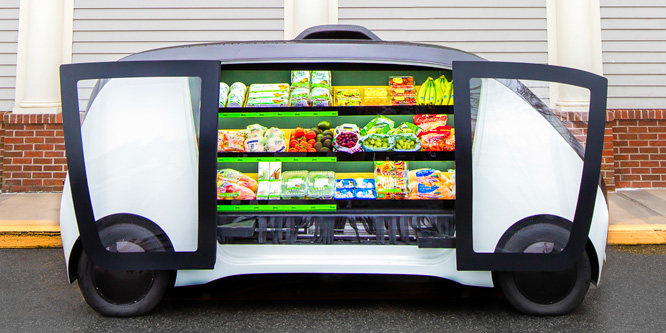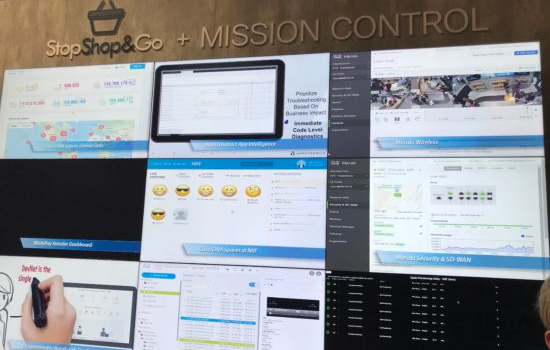
Photo: Stop & Shop; Robomart
Tech lets shoppers say ‘Optimize Me’ when ordering groceries
The line between digital and physical shopping continues to get fuzzier.
At NRF’s “Big Show” last week, Cisco showcased a concept called “Optimize Me” within its fictitious Stop, Shop & Go store.
Rather than the shopper buying everything online and picking it up in store (BOPIS), this scenario allows the shopper to save items in a grocer’s smartphone app as they go about their regular activities. They add items to a virtual shopping list as they think of what they need and then select “optimize me” within the app when they are ready to head to the store.
Using artificial intelligence (AI) technology, items purchased before and marked as favorites in the shopper’s profile are picked by store associates and placed at a designated in-store pickup area, while those products never purchased before remain in the shopping list. For those, customers go to the shelf to browse and select the items they prefer. The physical locations of these items are displayed on the shopper’s smartphone via a store map using location-based services. The customer still goes through the purchase process at the store (scan and go, self-checkout, traditional register, etc.), but they don’t have to trek through the store to pick up refill items.

An alternative approach to digital/physical shopping is soon to be available from Stop & Shop (owned by Ahold Delhaize USA), which plans to offer driverless vehicles that bring shoppers groceries when summoned by an app. The test should launch in Boston in the spring and the vehicles from startup Robomart Inc. will offer a selection of produce, meal kits and convenience items.
Customers request a visit from the nearest Robomart vehicle. When it arrives, they go outside, unlock the vehicle and make their selection from the shelves inside. The vehicle’s RFID and computer vision “grab and go” technology records the purchase, charges the customer and e-mails them a receipt. Mark McGowan, president of Stop & Shop, said the chain is leveraging this technology to “bring the store to them (customers).”
- NRF 2019 Key Takeaways to meet Consumer Expectations – Cisco Blogs
- See What DevNet Has In Store for the Retail Industry – Cisco Blogs
- Stop & Shop Brings On-Demand, Self-Driving Grocery Stores to Consumers – Stop & Shop/Globe Newswire
- Stop & Shop is planning to roll out small ‘driverless grocery stores’ in the Boston area – The Boston Globe
Discussion Questions
DISCUSSION QUESTIONS: Will optimizing a customer’s order and setting regularly ordered items aside make BOPIS easier for the shopper and the retailer? Will bringing a selection of items to the shopper by driverless vehicle pan out?


I am a bit torn on this. I like the technology and think optimization is smart. However, it seems like a bit of a hassle. I am still having to go to the store, walk around for items, then pick up my other items, then pay for them. And of course, there will inevitably be out-of-stocks and substitutions to deal with. On top of this, you won’t be able to see all the offers and deals on everyday items – which remains an important consideration for many shoppers when buying staples.
I also wonder how this will impact margins. If it took off, stores would have to do a lot more work to fulfill customer needs. They would also, by default, discourage visits to the center of the store where most staples are stocked.
I’m interested to see where this goes, but I am yet to be sold on the idea.
Personalizing to the customer’s typical needs is always a good idea. At the moment, I have heard many negative comments about whether a driverless vehicle service will work. In the short term, it may be more of a promotional or brand building exercise. But I definitely believe this will be part of normal every-day life five to 10 years from now (or whenever driverless cars become a normal reality). Exciting concept.
This will certainly “optimize” the shopping trip and goes further in blending discovery with replenishment but doesn’t go far enough to address the issue of an e-commerce model being layered on top of a traditional model. BOPIS “pickers” compete for inventory against physical shoppers leaving many retail stores with out-of-stock issues. The supply chain and demand planning of aging store systems still cannot forecast well enough to accommodate.
The miss on the experience will still be item replacement or OOS when they go to pick up their items, or worse when they get home.
Any technology that can optimize the shopper’s journey is valued. As AI technology matures it will become embedded into almost every facet of our lives — including shopping. The challenge for retailers will be how to implement these technologies and services cost-effectively. The only way this will happen will require retailers and their brand/vendor partners to collaborate and work together in ways they are historically not accustomed to working. Shoppers will quickly come to expect the services without paying a premium for them. A business conundrum created by the digital transformation. Autonomous vehicles being used for delivery make for great trade show demos and public relations fodder for quite a number of years.
The optimization concept will work most of the time. Grocery shopping is boring and this reduces the pain. There is nothing that says that the consumer cannot pick up additional items if desired. Go for it.
Sounds like a good idea with potential positive outcomes — if it truly saves both store and shopper a couple of steps in the process. The instant it causes confusion or extra steps it’s done. Let the testing and learning begin.
Customizing the shopping experience for consumers is a smart strategy, however the options are starting to become a little confusing. I like the idea of adding items to your shopping list app as you identify products you need. Splitting the pick-up of groceries into two segments — some items pre-picked by store associates and shopping for other items yourself –- seems cumbersome. The options are getting daunting. That said, I like the idea of giving customers option, but it has to be simple and convenient.
Regarding the driverless vehicle that makes the Amazon Go concept mobile, it is probably a concept that won’t be ubiquitous for many years.
The concepts are compelling but complexity gets in the way. Tracking the stuff I will replenish separately — even if the apps help me find what I want to select — becomes yet another task to execute, keep track of, and spend time on. If this can be made simple it might work.
If a large percent of the customer’s shopping is indeed replenished, it also might work — but I’ve yet to see data that shows that consumers are not continuously changing, e.g. kids, home, partners, moving, preferences, new routines, jobs, habits, and conscious decisions (like avoiding foods for diabetics) over time. This inherently makes simplicity and regularity in purchasing all the more difficult.
After some testing we might see results for select communities. The driverless delivery is also exciting, but needs infrastructure and community acceptance first.
This is what happens when AI meets the personal shopper. The experience will get the consumer in and out faster. Saving time is more convenient. Customers want — and like — this. As for the driverless vehicle concept, it has been tested in other parts of the world. This is an option that is normal in the not too distant future. In both of these examples, retailers are working hard to create customer convenience.
This concept is solid on the surface, but the challenge will be actually saving the customer time and money. It needs to be an easier way than BOPIS or traditional grocery shopping. As described, it seems like pairing BOPIS with in-store shopping in a way that could be more confusing for shoppers. A good concept, but testing is in order to find the right balance.